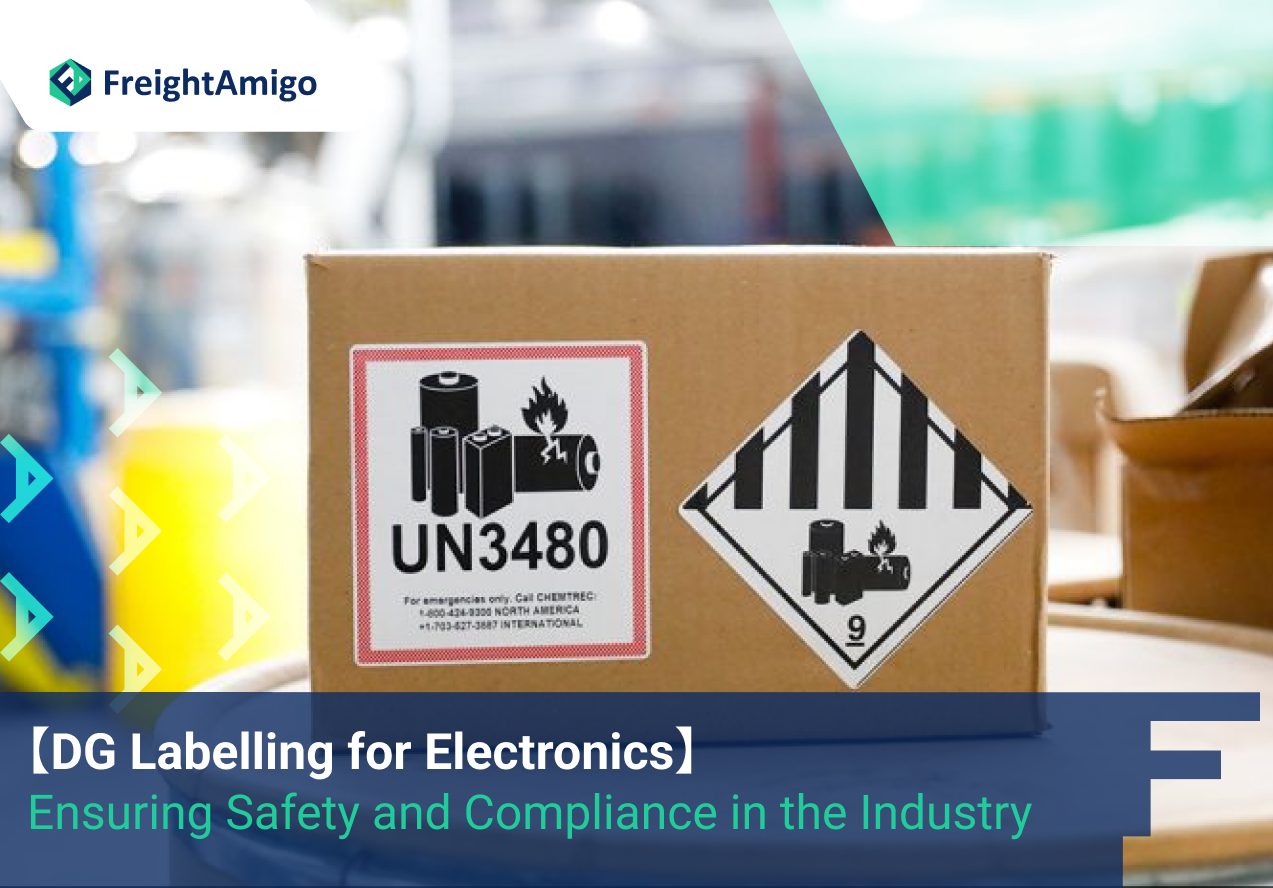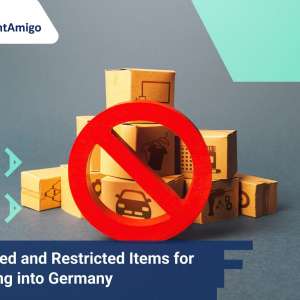19th January, 2024 Caspian Ng – Marketing Analyst at FreightAmigo
Proper labelling of dangerous goods (DG) is crucial in the fast-paced and ever-evolving electronics industry. Safe handling, transportation, and storage of hazardous materials cannot be overlooked due to the increasing demand for electronic devices and components. FreightAmigo has prepared this guide that explores the importance of DG labelling in the electronics industry. It covers the types of dangerous goods, mandatory labelling requirements, and the benefits of compliance. DG labelling ensures safety and compliance in this dynamic industry.
Want to compare the best Express, Air Freight, Sea Freight, Rail Freight & Trucking rates so as to have better control on cost?
Understanding Dangerous Goods in the Electronics Industry
Dangerous goods, also known as hazardous materials, are substances or articles that can harm health, safety, property, or the environment. The electronics industry uses these goods, including batteries, chemicals, solvents, and other materials, which are essential for producing and operating electronic devices. Correct identification and classification of these dangerous goods are crucial to ensure their safe handling and transportation.
Types of Dangerous Goods in the Electronics Industry
The electronics industry deals with a wide range of dangerous goods, each requiring specific labelling and handling procedures. Let’s explore some common types of dangerous goods found in the industry:
- Lithium Batteries: Lithium batteries are widely used in electronic devices due to their high energy density. However, they can be potentially hazardous if not handled correctly. Therefore, proper labelling and compliance with regulations are vital to ensure their safe transport and storage.
- Chemicals: The electronics industry relies on various chemicals for manufacturing processes, including solvents, acids, and cleaning agents. These chemicals can pose risks to human health and the environment, emphasizing the need for appropriate labelling and handling practices.
- Electronic Components: Certain electronic components, such as capacitors and resistors, may contain hazardous materials like lead or mercury. Accurately labelling these components can help identify potential risks and ensure proper handling and disposal.
Mandatory Labelling Requirements for Dangerous Goods
Compliance with mandatory labelling requirements is crucial for companies involved in the production, distribution, and shipping of electronic devices and components to ensure the safe handling and transportation of dangerous goods in the electronics industry. Let’s explore some of the key labelling requirements for dangerous goods:
CE Marking
CE marking is one of the most widely recognized mandatory marks required by the European Union (EU) for various product categories, including electronic devices. It indicates that the product meets all EU regulatory requirements related to safety, health, energy efficiency, and environmental concerns. While CE marking is not specific to dangerous goods, it plays a crucial role in ensuring compliance and consumer safety in the electronics industry.
Hazard Symbols and Pictograms
Hazard symbols and pictograms are essential components of dangerous goods labelling. They provide visual representations of the specific hazards associated with a product or material. In the electronics industry, these symbols and pictograms help in identifying the potential risks posed by chemicals, batteries, and other hazardous materials used in the production and operation of electronic devices.
UN Numbers and Proper Shipping Names
UN numbers and proper shipping names are vital for the accurate identification and classification of dangerous goods during transportation. UN numbers are internationally recognized codes assigned to specific substances or articles, while proper shipping names provide a clear description of the goods being transported. Including UN numbers and proper shipping names on labels ensures proper handling and compliance with transportation regulations.
Other Mandatory Labelling Requirements
In addition to CE marking, hazard symbols, UN numbers, and proper shipping names, there are various other mandatory labelling requirements specific to certain types of dangerous goods in the electronics industry. These may include labelling requirements for lithium batteries, chemical substances, radioactive materials, and more. It is essential for companies to stay updated with the latest regulations and ensure accurate labelling to maintain compliance.
Benefits of Compliance with DG Labelling in the Electronics Industry
Compliance with DG labelling requirements in the electronics industry offers numerous benefits, both for businesses and consumers. Let’s explore some of the key advantages of ensuring safety and compliance through proper labelling:
Safety and Risk Mitigation
The primary objective of DG labelling is to ensure the safety of individuals, property, and the environment. Accurate and visible labelling helps in identifying potential hazards, enabling proper handling, storage, and transportation of dangerous goods. By complying with labelling requirements, companies mitigate risks and minimize the chances of accidents, spills, and other safety incidents.
Legal Compliance and Avoidance of Penalties
Non-compliance with DG labelling regulations can result in severe consequences, including legal penalties, fines, and even suspension of business operations. Compliance with mandatory labelling requirements ensures that companies adhere to relevant laws and regulations, avoiding potential legal and financial repercussions.
Consumer Confidence and Trust
Proper labelling of dangerous goods enhances consumer confidence in the electronics industry. By demonstrating a commitment to safety and compliance, companies build trust with their customers. Consumers can make informed decisions based on the clear labelling of hazardous materials, promoting transparency and accountability within the industry.
Improved Supply Chain Efficiency
Accurate DG labelling facilitates smoother supply chain operations, reducing delays and improving overall efficiency. Properly labelled dangerous goods are easier to handle, store, and transport, streamlining logistics processes. Compliance with labelling requirements also minimizes the risk of rejected shipments or delays due to non-compliant packaging or documentation.
Enhanced Environmental Sustainability
Effective labelling of hazardous materials promotes responsible waste management and environmental sustainability. By clearly identifying dangerous goods, companies ensure their proper disposal and recycling, reducing the impact on the environment. Compliance with labelling requirements contributes to a more sustainable electronics industry.
Innovations in DG Labelling for Improved Customer Experience
As the electronics industry continues to evolve, advancements in DG labelling technologies are being introduced to enhance the customer experience. These innovations aim to simplify labelling processes, improve visibility, and provide additional information to consumers. Let’s explore some notable innovations in DG labelling for the electronics industry:
Smart Labelling Solutions
Smart labelling solutions, such as RFID (Radio-Frequency Identification) tags and QR codes, enable real-time tracking and monitoring of dangerous goods throughout the supply chain. These technologies provide enhanced visibility, allowing companies and consumers to access detailed information about the product’s origin, handling instructions, and safety precautions.
Interactive Labelling and Packaging
Interactive labelling and packaging solutions incorporate augmented reality (AR) and near field communication (NFC) technologies. These solutions enable consumers to access product information, safety instructions, and recycling guidelines by simply scanning the label or package with their smartphones. Interactive labelling enhances the customer experience and promotes responsible use and disposal of electronic devices.
Eco-Friendly Labelling Materials
The electronics industry is increasingly embracing eco-friendly labelling materials to promote sustainability and reduce environmental impact. Biodegradable and recyclable label materials, as well as non-toxic inks and adhesives, contribute to a greener approach to labelling dangerous goods. These innovations align with the industry’s commitment to environmental responsibility.
Intelligent Labelling Systems
Intelligent labelling systems leverage automation and artificial intelligence (AI) to streamline labelling processes. These systems can automatically generate and apply labels based on the specific requirements of each product or hazardous material. Intelligent labelling systems improve efficiency, reduce errors, and ensure accurate and compliant labelling in the fast-paced electronics industry.
Make DG Labelling Easier
DG labelling plays a vital role in ensuring the safety, compliance, and sustainability of the electronics industry. By accurately labelling and identifying dangerous goods, companies can mitigate risks, minimize accidents, and build consumer trust. Ensuring accurate dangerous goods labeling is critical yet complex, especially for industries like electronics handling diverse hazardous materials globally. At FreightAmigo, we’re committed to helping our customers strengthen DG compliance through comprehensive solutions. Customers can rest assured that regulations are always followed correctly. Additionally, our 24/7 support line promptly addresses any new requirements or clarifications.
We take labeling into our hands, allowing your supply chain team to focus on core operations. Contact us to learn how we can assist your organization.
Read More:
【Logistics 101】The Importance of Marking and Labelling Dangerous Goods in Shipping
【DG Labelling for Electronics】 Ensuring Safe and Compliant Transportation in the Supply Chain
【DG Labeling Demystified】 Expert Tips for Electronic Device Warehousing and Distribution
If you have any inquiries on logistics/supply chain, feel free to contact FreightAmigo:
Chat with us online | Hotline: +852 28121686 | WhatsApp: +852 27467829








































